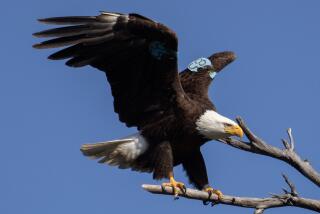Bald eagle festival in Squamish, Canada, celebrates America’s symbol
After 40 years, the winter count of bald eagles in the San Bernardino National Forest is coming to an end. Although local bird-watchers may be disappointed, it’s good news because the number of white-headed raptors has stabilized there.
The San Bernardino total was usually a dozen or so eagles, but for a chance to see countless numbers of Haliaeetus leucocephalus, head north to Squamish in Canada’s British Columbia, which holds an annual count the first Sunday of the new year as part of the month-long Brackendale Eagle Festival and Count 2020.
The festival, which has its headquarters about 5 ½ miles north of Squamish at a Brackendale art gallery, features concerts, lectures, art shows, screenings and tours.
At the center of events is the gallery’s colorful owner, artist Thor Froslev, who invited the inaugural volunteers in 1986 and has been the host and champion of the “World Eagle Capital” ever since.
The walls of the cabin/gallery are lined with eagle art and other modern pieces and has a small café and a Transformers-like tower sculpture that does double duty as a sanctuary for injured baldies.
The specially trained volunteers canvass 20 locations in a 40-mile area on foot, snowshoe, ski and raft, then return to the gallery’s blazing fireplace with their observations and figures, which are entered on an old school chalkboard.
The wait for the final tally is surprisingly tense; unpredictable factors including frozen lakes, water levels and the strength of the salmon run can affect the numbers of the yellow-beaked birds.
The total hit a 3,769 in 1994 but sank to 411 in 2016, but the numbers have been creeping up since then, hitting more than 1,000 last year.
Where to spot them
For the visitor, numerous eagle-viewing sites running along the Squamish River in the 1.4-million-acre Brackendale Eagles Provincial Park mean you have a good chance of seeing the iconic birds.
First stop should be the Eagle Run dike, which is closest to the Sea to Sky Highway (British Columbia 99) and is north of downtown Squamish.
It’s the home of the EagleWatch viewing shelter, where weekend volunteers answer questions and you can learn about eagles and their salmon prey and look through smartphone camera-compatible high-powered telescopes.
You’ll find large wooden carvings of baldies along the path, and the tree-lined river itself is an ideal habitat for the eagles, which build enormous, heavy nests several feet wide and deep.
These nests are often the first thing you see before your eyes adjust and you start making out their silhouettes on branches or see flashes of them swooping, talon-first, down to the water to snatch up fish.
Even during a casual visit to the area, you’re likely to spot a bald eagle in a tree, atop an electricity pylon or in flight, but if hiking and binoculars aren’t for you, then there are other ways.
“Eagle floats” (raft trips) on the river and its tributaries are a calm way to see the eagles, especially when they take wing alongside or overhead, but there are also bike rides, walking tours and even expeditions on horseback that take you into eagle country.
All usually feature hot chocolate or a campfire at the end, and the views of the Stawamus Chief and Garibaldi Ranges are always spectacular.
Wrap up the day in Squamish, a rapidly growing resort town between Vancouver and the more-crowded Whistler. You can get warm in several ways, including gins, ciders and beers from local distilleries and breweries.
Eagle watching tips
Early morning and mid-afternoon are the best times to look for bald eagles. Keep your eyes on the tallest trees, because that’s where they are most likely to roost.
Stay on the paths and dikes, keep quiet, keep your distance from eagles — and their food — and ensure that all dogs are kept on a leash.
Leave your drones at home. They’re nowhere near as impressive as America’s bird.
Info: Explore Squamish
More to Read
Sign up for The Wild
We’ll help you find the best places to hike, bike and run, as well as the perfect silent spots for meditation and yoga.
You may occasionally receive promotional content from the Los Angeles Times.






